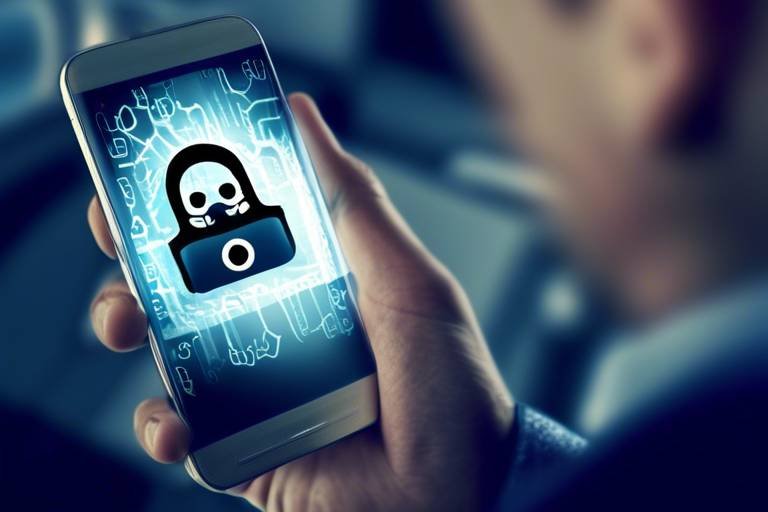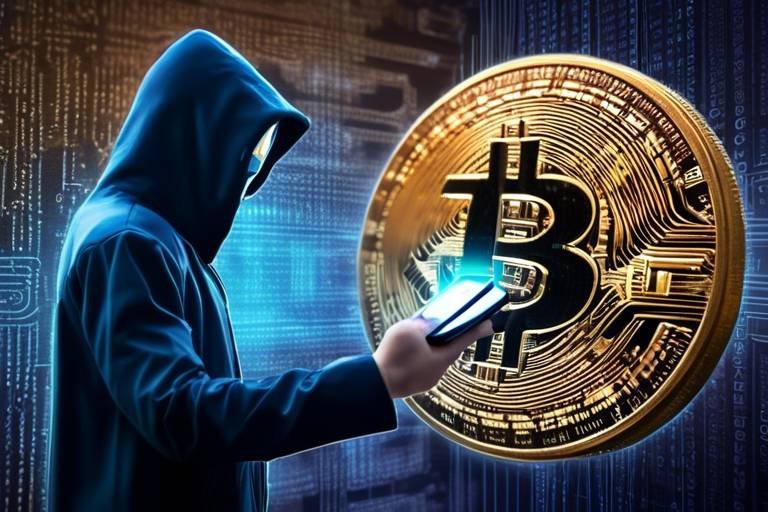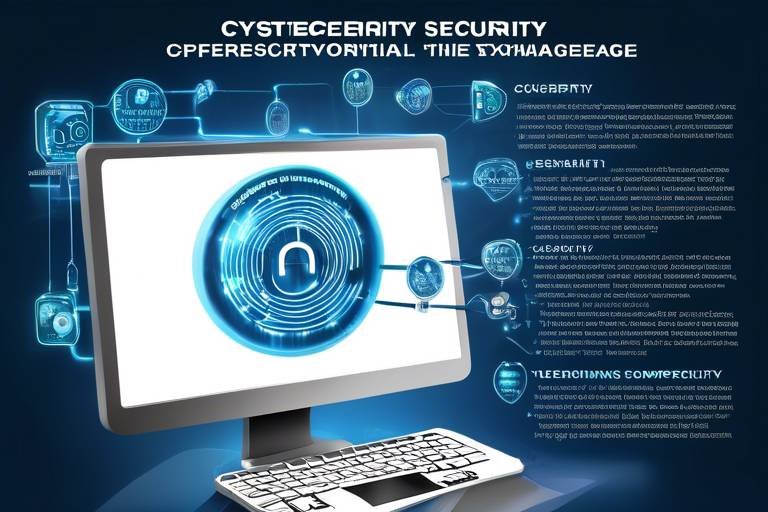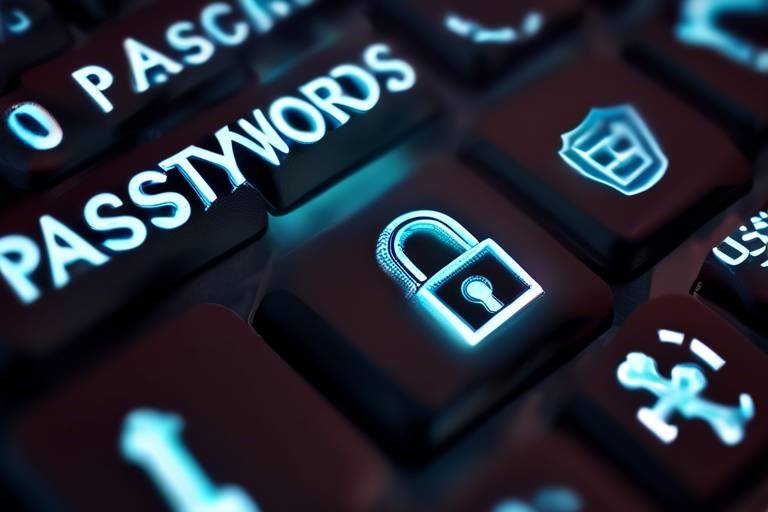How to Safely Use Online Payment Systems
In today's fast-paced digital world, online payment systems have become a staple for both consumers and businesses. Whether you’re buying the latest gadget, paying bills, or transferring money to a friend, the convenience they offer can be hard to resist. But with this convenience comes a pressing need for vigilance. How can you ensure that your transactions remain secure? This article dives deep into the best practices for securely utilizing online payment systems, ensuring user safety, and minimizing risks associated with online transactions.
Online payment systems are platforms that facilitate electronic transactions and allow users to pay for goods and services over the internet. These systems have evolved significantly, transforming the way we conduct business and manage our finances. From credit cards to digital wallets, the variety of payment options available today is astounding.
There are several types of online payment systems, including:
- Credit and Debit Cards: The traditional method, widely accepted across various platforms.
- Digital Wallets: Services like PayPal, Apple Pay, and Google Wallet that store payment information and allow for quick transactions.
- Cryptocurrency: Emerging as a new form of payment, offering decentralized and secure transactions.
These systems not only simplify transactions but also open doors to global commerce, allowing businesses to reach customers far beyond their local markets. However, with this increased accessibility comes the responsibility of ensuring safe usage.
While online payment systems offer convenience, they also come with their fair share of risks. Fraud, phishing attacks, and data breaches are just a few of the threats that can compromise your financial security. It’s crucial to be aware of these risks to protect yourself while making transactions.
Understanding the different types of online payment fraud is essential for users. Here are some common threats:
- Credit Card Fraud: Unauthorized use of someone’s credit card information to make purchases.
- Identity Theft: Criminals stealing personal information to impersonate someone else.
- Chargebacks: Disputes initiated by the consumer that can lead to financial losses for merchants.
Being informed about these threats can help you take proactive measures to safeguard your finances.
Phishing scams are deceptive tactics used by fraudsters to trick individuals into providing personal information. These scams often come in the form of emails or messages that appear to be from legitimate sources. They may ask you to click on a link or provide sensitive information, such as credit card numbers or passwords. Always verify the source before clicking on any links or providing information.
Account takeover fraud occurs when an attacker gains unauthorized access to your accounts, often through stolen credentials. This can lead to unauthorized transactions and significant financial loss. To protect yourself, it’s vital to use strong, unique passwords and enable two-factor authentication wherever possible.
So, how can you protect yourself from these risks? Here are some essential measures you can implement:
- Use Strong Passwords: Create complex passwords that are difficult to guess and change them regularly.
- Enable Two-Factor Authentication: This adds an extra layer of security by requiring a second form of verification.
- Monitor Account Activity: Regularly check your account statements for any unauthorized transactions.
By adopting these practices, you can significantly enhance your online payment security.
Selecting a secure and reliable online payment platform is crucial. With so many options available, it’s important to consider several factors before making your choice. Look for platforms that offer robust security features, positive user reviews, and transparent transaction fees.
When evaluating payment platforms, pay close attention to their security features. Reputable platforms typically offer:
- Encryption: Protects your data during transmission.
- Fraud Detection: Monitors transactions for suspicious activity.
- Customer Support: Provides assistance in case of any issues.
These features can provide peace of mind when conducting online transactions.
Before committing to any payment platform, take the time to read user reviews and ratings. This will give you insight into the experiences of other users and help you gauge the reliability and security of the platform.
Conducting secure online transactions is not just about choosing the right platform; it also involves adopting best practices. Here are some tips to keep in mind:
Always use secure, private networks when making online payments. Public Wi-Fi can be a hotbed for cybercriminals looking to intercept your data. If you must use public Wi-Fi, consider using a VPN for an added layer of security.
Keeping your devices and payment applications updated is crucial. Updates often include security patches that protect against vulnerabilities. Make it a habit to regularly check for updates to ensure you have the latest security measures in place.
1. What should I do if I suspect fraud on my account?
If you suspect fraud, immediately contact your bank or payment provider to report the issue and take necessary actions to secure your account.
2. Are digital wallets safer than credit cards?
Digital wallets can offer enhanced security features like encryption and tokenization, making them a safer option for many users.
3. How can I recognize a phishing email?
Look for suspicious email addresses, poor grammar, and requests for sensitive information. Always verify the sender before clicking on links.

Understanding Online Payment Systems
In today's fast-paced digital world, online payment systems have revolutionized the way we conduct transactions. Gone are the days of carrying cash or writing checks; now, with just a few clicks, you can purchase anything from groceries to gadgets. But what exactly are online payment systems? At their core, they are platforms that enable consumers and businesses to exchange money electronically, securely, and conveniently. These systems have become a lifeline in the e-commerce landscape, offering various functionalities that cater to the needs of users.
There are several types of online payment systems, including:
- Credit and Debit Card Payments: The most common method, allowing users to pay directly from their bank accounts or credit lines.
- Digital Wallets: Services like PayPal, Apple Pay, and Google Wallet that store your payment information securely, making transactions faster and easier.
- Bank Transfers: Direct transfers from one bank account to another, often used for larger transactions.
- Cryptocurrency Payments: An emerging trend where digital currencies like Bitcoin are used for online transactions.
These systems have not only made shopping more accessible but have also streamlined the payment process for businesses. Imagine a world where you can buy a product from an international seller without worrying about currency exchange or lengthy bank transfers. That's the beauty of online payment systems—they break down geographical barriers and make the world a smaller place.
However, with great convenience comes great responsibility. As we embrace these technologies, it’s essential to understand how they work and what measures we need to take to ensure our safety. Online payment systems typically operate through a series of secure protocols that encrypt your data, making it difficult for unauthorized parties to gain access. This encryption is vital, but it’s just one piece of the puzzle when it comes to protecting your financial information.
In conclusion, understanding online payment systems is crucial for anyone looking to navigate the digital marketplace safely. By grasping their functionalities and the various types available, users can make informed decisions and enjoy the convenience of online transactions while minimizing risks. So, whether you're a seasoned online shopper or a business owner venturing into e-commerce, being well-versed in these systems will undoubtedly enhance your experience.
Q: What are the most secure online payment methods?
A: Credit and debit cards with fraud protection, digital wallets with encryption, and bank transfers are generally considered secure options. Always look for platforms that offer two-factor authentication.
Q: Can I use online payment systems internationally?
A: Yes, many online payment systems allow for international transactions, but be aware of potential fees and currency conversion rates.
Q: How can I protect myself when using online payment systems?
A: Use strong passwords, enable two-factor authentication, and always monitor your account activity for any unauthorized transactions.

Recognizing Potential Risks
In the ever-evolving digital landscape, online payment systems have revolutionized the way we conduct transactions. However, with this convenience comes a host of potential risks that every user should be aware of. Understanding these risks is the first step toward safeguarding your financial information. Let's dive into the murky waters of online payment threats, where lurking dangers can strike when least expected.
One of the most prevalent risks is fraud. This can manifest in various forms, such as credit card fraud, where unauthorized individuals use your card information to make purchases. Imagine waking up to find that your hard-earned money has vanished overnight, leaving you to deal with the aftermath. It's a nightmare scenario, but one that is all too common in today's digital economy. Additionally, phishing attacks have become a favorite tactic for cybercriminals. They often disguise themselves as legitimate entities, sending out emails or messages that appear to be from trusted sources, all in an effort to trick you into revealing sensitive information.
Moreover, the threat of data breaches looms large. In these incidents, hackers gain unauthorized access to databases containing personal information, including payment details. This can lead to identity theft, where your identity is stolen and used for fraudulent purposes. It's like handing over the keys to your home, only to find that someone else has moved in. The importance of being vigilant while making online transactions cannot be overstated. Users must constantly be on the lookout for any signs of suspicious activity, whether it's an unexpected charge on their statement or an email that seems slightly off.
To better understand the landscape of online payment fraud, it's essential to recognize the different types that exist. Here are a few common forms:
- Credit Card Fraud: This occurs when someone uses your credit card information without your permission.
- Identity Theft: Cybercriminals can steal your personal information to impersonate you and commit fraud.
- Chargebacks: This is a process where a consumer disputes a charge, leading to a reversal of the payment, often exploited by fraudsters.
Phishing scams are particularly insidious. They often come in the form of emails that look legitimate, complete with company logos and official-sounding language. The goal is to get you to click on a link that leads to a fake website designed to steal your login credentials or payment information. To protect yourself, always scrutinize the sender's email address and look for signs of a scam, such as poor grammar or urgent calls to action.
Account takeover fraud is another alarming risk. In this scenario, attackers gain unauthorized access to your online accounts, often through stolen login credentials. Imagine waking up to find that someone has changed your password and locked you out of your own account. This type of fraud can have devastating consequences, especially if it involves financial accounts. To safeguard against this, consider implementing strong, unique passwords for each account and enabling two-factor authentication whenever possible.
In conclusion, recognizing potential risks associated with online payment systems is crucial for protecting your financial well-being. By staying informed and adopting proactive measures, you can significantly reduce the chances of falling victim to these threats. Remember, in the world of online payments, being cautious is not just a good habit; it's a necessity.

Types of Online Payment Fraud
In today’s digital landscape, the convenience of online payment systems comes with a dark side—fraud. Understanding the various types of online payment fraud is crucial for anyone engaging in digital transactions. Fraudsters are becoming increasingly sophisticated, employing a range of tactics to exploit unsuspecting users. Among the most common forms of online payment fraud are credit card fraud, identity theft, and chargebacks. Each type poses unique threats and requires different preventive measures.
Credit card fraud is perhaps the most notorious type of online payment fraud. It involves the unauthorized use of someone’s credit card information to make purchases. This can happen when hackers obtain card details through data breaches or phishing attacks. Once they have this information, they can make purchases without the cardholder’s knowledge. Victims often only realize something is wrong when they receive unexpected charges on their statements. To combat this, users should regularly monitor their financial accounts and report any suspicious activity immediately.
Another prevalent issue is identity theft, where criminals steal personal information, such as Social Security numbers or bank account details, to impersonate someone else. This can lead to unauthorized transactions, loans taken out in the victim's name, and a host of other financial problems. The emotional toll can be just as damaging as the financial repercussions. Protecting personal information is crucial; users should be cautious about sharing sensitive details online and ensure that they are using secure websites.
Lastly, let's talk about chargebacks. While chargebacks are a legitimate consumer protection tool, they can also be exploited by fraudsters. A chargeback occurs when a consumer disputes a transaction with their bank, leading to a reversal of funds. Some individuals may make purchases with the intent of returning items they never intended to keep, thus committing fraud against the merchant. This not only affects the businesses involved but can also lead to increased prices for consumers as businesses try to recover losses.
To summarize, being aware of these types of online payment fraud is the first step in protecting oneself. Here’s a quick recap:
- Credit Card Fraud: Unauthorized use of credit card information.
- Identity Theft: Stealing personal information for fraudulent activities.
- Chargebacks: Disputing transactions that can be exploited by fraudsters.
By recognizing these threats, users can take proactive steps to safeguard their information and finances. The digital world is like a bustling marketplace, filled with opportunities but also potential pitfalls. Just as you wouldn’t leave your wallet unattended in a crowded area, it’s essential to stay alert and informed when navigating online payment systems.
Q: What should I do if I suspect fraud on my account?
A: Immediately contact your bank or credit card company to report the suspicious activity. They can help you secure your account and investigate the issue.
Q: How can I protect myself from identity theft?
A: Use strong, unique passwords for each account, enable two-factor authentication, and regularly monitor your financial statements for any unauthorized transactions.
Q: Are chargebacks always a sign of fraud?
A: Not necessarily. Chargebacks can be a legitimate consumer protection tool, but they can also be exploited. Always keep records of your transactions to support your claims.

Phishing Scams
Phishing scams are one of the most insidious threats lurking in the digital shadows, preying on unsuspecting individuals and businesses alike. Imagine receiving an email that looks like it’s from your bank, complete with their logo and branding, urging you to click a link and verify your account information. It’s a classic bait-and-switch tactic, designed to trick you into providing sensitive data like passwords and credit card numbers. These scams can be incredibly convincing, and that’s what makes them so dangerous.
Understanding how phishing scams operate is crucial for safeguarding your online transactions. Typically, these scams involve an email or message that appears legitimate, but it’s actually a cleverly disguised trap. The goal is to lure you into clicking a link that leads to a fake website, which looks almost identical to the real one. Once there, you might be prompted to enter your personal information, which the scammers can then use for fraudulent activities.
To help you recognize phishing attempts, here are a few red flags to watch out for:
- Generic Greetings: If the email starts with "Dear Customer" instead of your name, it’s a warning sign.
- Urgent Calls to Action: Be wary of messages that create a sense of urgency, like "Your account will be suspended!"
- Suspicious Links: Hover over links (without clicking) to see the actual URL. If it’s different from the official website, don’t click!
- Spelling and Grammar Mistakes: Many phishing emails are poorly written. If you notice errors, it’s likely a scam.
So, how can you protect yourself from falling victim to these scams? First, always verify the sender’s email address. Scammers often use addresses that look similar to legitimate ones but have slight differences. Additionally, never click on links in unsolicited emails. Instead, type the website address directly into your browser to ensure you’re visiting the legitimate site. It might seem tedious, but taking that extra step can save you from a world of trouble.
Another effective strategy is to enable two-factor authentication (2FA) on your accounts. This adds an extra layer of security, making it harder for scammers to gain access even if they manage to steal your password. And don’t forget to regularly monitor your accounts for any suspicious activity. If you notice anything unusual, report it immediately.
In conclusion, phishing scams are a persistent threat in our increasingly digital world. By staying informed and vigilant, you can greatly reduce your risk of falling prey to these malicious tactics. Remember, when it comes to online security, it’s always better to be safe than sorry!

Account Takeover
Account takeover fraud is a sneaky and increasingly common threat in the digital landscape. Imagine waking up one day to find that your online bank account, social media profiles, and even shopping accounts have been hijacked by a malicious actor. This type of fraud occurs when an attacker gains unauthorized access to your accounts, often using stolen credentials or exploiting security weaknesses. The consequences can be devastating, leading to financial loss, identity theft, and a significant amount of stress as you scramble to regain control.
So, how do these attackers manage to pull off such a heist? They typically rely on a combination of tactics, including:
- Phishing: Deceptive emails or messages that trick users into providing their login details.
- Data Breaches: Leaked information from compromised companies that can include usernames and passwords.
- Weak Passwords: Many users still opt for easily guessable passwords, making it a walk in the park for hackers.
To protect yourself from account takeover, it's crucial to adopt a proactive approach. Here are some effective strategies:
- Use Strong, Unique Passwords: Create complex passwords that include a mix of letters, numbers, and symbols. Avoid using the same password across multiple accounts.
- Enable Two-Factor Authentication (2FA): This adds an extra layer of security by requiring a second form of verification, such as a text message code or authentication app, in addition to your password.
- Regularly Monitor Account Activity: Keep an eye on your account statements and activity logs. If you notice any suspicious transactions or changes, act immediately.
Additionally, consider using a password manager to keep track of your passwords securely. These tools can generate strong passwords and store them safely, making it less likely that you'll fall victim to an account takeover. Remember, staying vigilant is your best defense against these types of attacks. The digital world can be a wild west, but with the right precautions, you can navigate it safely and securely.
Q: What should I do if I suspect my account has been taken over?
A: If you suspect an account takeover, immediately change your password and enable two-factor authentication. Contact the service provider's customer support for assistance in securing your account.
Q: Can I recover my account after a takeover?
A: Yes, most online services have recovery processes in place. However, the speed and success of recovery can vary depending on the service provider and the extent of the compromise.
Q: How can I tell if my account is at risk?
A: Look for unusual login attempts, notifications of password changes you didn't initiate, or unfamiliar transactions. If anything seems off, take action immediately.

Protective Measures for Users
In today's digital landscape, ensuring the safety of your online transactions is more crucial than ever. With the rise of online payment systems, it's essential to implement protective measures that can safeguard your personal and financial information. So, what can you do to fortify your online presence and keep potential threats at bay? Let's dive into some effective strategies that will help you stay secure while navigating through the world of online payments.
First and foremost, using strong passwords is a fundamental step in protecting your accounts. A password should be a mix of uppercase and lowercase letters, numbers, and special characters. Avoid using easily guessable information like birthdays or common words. To make it easier to manage multiple passwords, consider using a reputable password manager, which can generate and store complex passwords securely.
Another vital protective measure is enabling two-factor authentication (2FA). This extra layer of security requires not just a password, but also a second form of identification, such as a text message or an authentication app. Think of it as having a double lock on your front door; even if someone has your key (password), they still need that second lock (2FA) to get in. This significantly reduces the risk of unauthorized access to your accounts.
Additionally, it's important to regularly monitor your account activity. Keep an eye on your bank statements and transaction history for any suspicious activity. If you notice anything out of the ordinary, report it immediately. Many financial institutions offer real-time alerts for transactions, which can help you catch fraud early. Remember, the sooner you act, the less damage can be done.
Moreover, educating yourself about phishing scams is crucial. Phishing attempts often come in the form of emails or messages that appear to be from legitimate sources, asking you to provide sensitive information. Always verify the sender's email address and look for signs of phishing, such as poor grammar, urgent requests, or suspicious links. When in doubt, go directly to the official website instead of clicking on links in emails.
Lastly, consider using a virtual private network (VPN) when accessing public Wi-Fi networks. Public networks are often less secure, making them a prime target for cybercriminals looking to intercept your data. A VPN encrypts your internet connection, adding a layer of security that helps protect your information from prying eyes. Think of it as a secure tunnel through which your data travels, keeping it safe from potential threats.
By implementing these protective measures, you can significantly enhance your online security and enjoy the convenience of online payment systems without the looming fear of fraud or identity theft. Remember, staying proactive and informed is your best defense against the ever-evolving landscape of online threats.
- What is two-factor authentication, and why is it important?
Two-factor authentication (2FA) adds an extra layer of security by requiring a second form of identification beyond just your password. This makes it much harder for unauthorized users to access your account. - How can I recognize phishing attempts?
Look for signs such as poor grammar, urgent requests, and suspicious links in emails. Always verify the sender's email address and avoid clicking on links unless you are certain they are legitimate. - Is using public Wi-Fi safe for online transactions?
Public Wi-Fi networks are often less secure and can be targeted by cybercriminals. It's advisable to use a VPN or avoid online transactions on public networks altogether. - What should I do if I suspect fraud on my account?
If you notice any suspicious activity, report it to your bank or payment provider immediately. They can help you take the necessary steps to secure your account.

Choosing the Right Payment Platform
In today's fast-paced digital world, selecting the right online payment platform is crucial for both consumers and businesses. With so many options available, it can feel overwhelming to make a choice that balances security, cost, and convenience. So, how do you navigate this sea of options? First, it's essential to understand what makes a payment platform reliable and trustworthy. You want a platform that not only meets your transaction needs but also protects your sensitive information.
When evaluating potential platforms, consider the following key factors:
- Security Features: Look for platforms that offer robust security measures, such as end-to-end encryption and fraud detection systems. These features are your first line of defense against online threats.
- User Reviews: Reading user experiences can provide valuable insights into the reliability and performance of a payment platform. Look for platforms with positive feedback and a good track record.
- Transaction Fees: Different platforms have varying fee structures. Some may charge a flat fee per transaction, while others may take a percentage of the total amount. Understanding these fees can help you avoid unexpected costs.
- Customer Support: A responsive customer support team can make a world of difference if you encounter issues. Ensure the platform you choose has accessible support options, such as live chat or phone assistance.
To illustrate these factors further, let's take a look at a comparison table of popular payment platforms:
| Payment Platform | Security Features | User Ratings | Transaction Fees | Customer Support |
|---|---|---|---|---|
| PayPal | Encryption, Fraud Detection | 4.5/5 | 2.9% + $0.30 per transaction | 24/7 Support |
| Square | Encryption, PCI Compliance | 4.6/5 | 2.6% + $0.10 per transaction | Phone & Email Support |
| Stripe | Encryption, Advanced Fraud Prevention | 4.7/5 | 2.9% + $0.30 per transaction | Email Support |
As you can see from the table, each platform has its strengths and weaknesses. It's vital to align these features with your specific needs. For instance, if you're a small business owner looking for a low-cost solution, Square might be a better fit for you. On the other hand, if you require advanced fraud protection, Stripe could be the way to go.
Ultimately, the right payment platform should not only facilitate smooth transactions but also give you peace of mind knowing that your financial information is secure. Take your time to research and evaluate your options thoroughly. After all, investing a little extra effort in choosing the right platform can save you a lot of headaches down the line.
Q: What should I prioritize when choosing a payment platform?
A: Focus on security features, user reviews, transaction fees, and customer support.
Q: Are there free payment platforms available?
A: While many platforms charge fees, some offer free services with limited features. Always review the terms before signing up.
Q: How can I ensure my transactions are secure?
A: Use platforms with strong security measures, keep your devices updated, and avoid using public Wi-Fi for transactions.

Evaluating Security Features
When it comes to online payment platforms, security should be your top priority. After all, you wouldn’t hand your wallet to a stranger on the street, right? The same logic applies to digital transactions. Evaluating the security features of payment platforms is crucial to ensuring that your financial information remains safe. Let's dive into the essential security measures you should look for when selecting a payment platform.
First and foremost, encryption is a fundamental feature that protects your data during transmission. Look for platforms that utilize SSL (Secure Socket Layer) encryption, which scrambles your information, making it nearly impossible for unauthorized users to access it. If a platform lacks this feature, it's a red flag. You can usually identify secure websites by the "https://" in their URL, where the "s" stands for secure.
Another critical feature is fraud detection. Reputable payment platforms employ sophisticated algorithms to monitor transactions for suspicious activity. This can include unusual spending patterns or transactions from unfamiliar locations. If a platform has a robust fraud detection system, it can alert you to potential threats before they escalate. Some platforms even offer real-time alerts for transactions, giving you an extra layer of protection.
Furthermore, customer support is an often-overlooked aspect of security. In the event of a problem, having access to responsive customer support can make all the difference. Look for platforms that provide multiple ways to reach their support team, such as live chat, phone support, and email. A platform that prioritizes customer service is more likely to take security seriously, providing you with peace of mind.
Lastly, consider the platform's reputation in the market. Research user reviews and ratings to get a sense of how well the platform handles security issues. Platforms with a history of data breaches or unresolved security complaints should be approached with caution. A quick search online can reveal a wealth of information about user experiences and the overall reliability of the payment service.
In summary, evaluating security features is not just a precaution—it's a necessity. By focusing on encryption, fraud detection, customer support, and platform reputation, you can make an informed decision that protects your financial information. Remember, in the world of online payments, it's better to be safe than sorry!
- What is SSL encryption, and why is it important?
SSL encryption protects your data during transmission, making it unreadable to unauthorized users. It’s essential for safeguarding sensitive information. - How can I know if a payment platform is reliable?
Check user reviews, ratings, and the platform’s history regarding security breaches to gauge its reliability. - What should I do if I suspect fraud on my account?
Immediately contact the payment platform’s customer support, review recent transactions, and change your passwords.

Reading User Reviews
When it comes to choosing an online payment platform, user reviews can be your best friend. Think of them as the digital word-of-mouth that can guide your decision-making process. Just like asking a friend for their opinion on a restaurant before dining there, diving into user reviews can help you understand the pros and cons of a payment platform. But how do you sift through the noise to find valuable insights?
First and foremost, look for platforms that have a substantial number of reviews. A few glowing reviews might seem enticing, but they can also be misleading. A platform with hundreds or thousands of reviews is likely to provide a more accurate picture of the user experience. Pay attention to the overall rating, but don't stop there. Read through the comments to get a sense of common themes—are users praising the ease of use, or are they complaining about hidden fees?
Moreover, consider the credibility of the reviews. Are they from verified users, or do they appear to be fabricated? Some platforms might offer incentives for positive reviews, which can skew the overall impression. Look for reviews that provide detailed accounts of the user's experience, including specific examples of what worked well and what didn't. This level of detail can often reveal the truth behind the ratings.
Another aspect to consider is the recency of the reviews. A platform might have been excellent a few years ago but could have declined in service or features since then. Always check for the most recent feedback to ensure you're getting the current state of affairs. For example, if a payment platform recently updated its features, user reviews can provide insight into how well those changes have been received.
Lastly, don't just focus on positive reviews. While it's easy to get swayed by a sea of five-star ratings, it's often the negative reviews that can provide the most valuable information. They can alert you to potential issues that you might encounter down the line. Look for patterns in the complaints—if multiple users are experiencing the same problem, it's a red flag that you may want to heed.
In summary, reading user reviews is an essential step in selecting the right online payment platform. By focusing on the number of reviews, their credibility, recency, and a balanced view of both positive and negative feedback, you can make a more informed decision. Remember, in the world of online payments, knowledge is power!
- What should I look for in user reviews? Focus on the number of reviews, credibility, recency, and both positive and negative feedback.
- How can I tell if a review is genuine? Look for detailed accounts and verified user tags that indicate authenticity.
- Are all reviews important? Yes, both positive and negative reviews can provide valuable insights into a platform's reliability and performance.
- Where can I find user reviews? Check the payment platform's website, third-party review sites, and social media platforms for feedback.

Best Practices for Secure Transactions
In today's fast-paced digital world, ensuring the security of your online transactions is not just a good idea; it's essential. With the rise of e-commerce and online banking, the methods we use to conduct transactions have evolved, but so have the tactics of cybercriminals. To protect yourself, it’s crucial to adopt . These practices are like a sturdy lock on your front door, keeping unwanted intruders at bay. So, what can you do to safeguard your financial information while shopping online or transferring money?
First and foremost, always use secure networks. This means avoiding public Wi-Fi when making transactions. Imagine you're at a cafe, sipping your favorite coffee, and connecting to their free Wi-Fi. It feels convenient, right? However, this convenience can come at a cost. Public networks are often less secure and can be breeding grounds for hackers who are eager to intercept your sensitive data. Instead, opt for your mobile data or a trusted private network whenever possible. If you must use public Wi-Fi, consider using a Virtual Private Network (VPN) to encrypt your connection.
Another critical practice is to regularly update your software. Whether it's your operating system, browser, or payment application, keeping everything updated ensures that you have the latest security patches. Think of it this way: just like you wouldn’t drive a car with outdated brakes, you shouldn’t use outdated software that could leave you vulnerable to attacks. Software updates often include fixes for vulnerabilities that hackers might exploit, so make it a habit to check for updates frequently.
Additionally, using strong passwords is non-negotiable. A strong password is your first line of defense against unauthorized access. Instead of using easily guessable information like birthdays or “123456,” create a complex password that combines letters, numbers, and symbols. For example, instead of “Password123,” try something like “P@55w0rd!2023.” It may take a bit more effort to remember, but the peace of mind it provides is worth it. To make things easier, consider using a password manager to keep track of your passwords securely.
Enabling two-factor authentication (2FA) adds an additional layer of security. This feature requires not only your password but also a second form of verification, such as a code sent to your phone. It’s like having a bouncer at the door of your online accounts. Even if someone manages to steal your password, they won’t be able to access your account without that second piece of information. Most reputable payment platforms offer 2FA, so take advantage of it!
Lastly, always monitor your account activity. Regularly checking your bank statements and transaction history can help you spot any unauthorized transactions early on. If you notice anything suspicious, report it immediately. It’s much easier to address a problem quickly than to deal with the aftermath of identity theft or fraud. Keep in mind that many banks offer alerts for transactions, so consider setting those up for added awareness.
In summary, adopting these best practices for secure transactions can significantly reduce your risk of falling victim to online fraud. By using secure networks, keeping your software updated, creating strong passwords, enabling two-factor authentication, and monitoring your account activity, you can navigate the digital marketplace with confidence. Remember, in the world of online payments, being proactive is the key to staying safe!
- What should I do if I suspect fraud on my account? Immediately contact your bank or payment provider to report the suspicious activity and follow their guidance on securing your account.
- Is it safe to save my payment information on websites? While convenient, it’s safer to avoid saving your payment information on websites. If you do, ensure the site is reputable and uses secure encryption.
- How can I tell if a website is secure? Look for URLs that begin with "https://" and a padlock icon in the address bar. These indicate that the site uses encryption to protect your data.

Using Secure Networks
In today's hyper-connected world, the importance of using secure networks when making online payments cannot be overstated. Imagine walking through a crowded market, wallet in hand, with your cash and credit cards on full display. Now, think about how you would feel if someone were to snatch it away in an instant. This is akin to using public Wi-Fi for financial transactions—you're essentially exposing your sensitive information to potential thieves lurking in the digital shadows.
When you connect to a public Wi-Fi network, whether at a coffee shop, airport, or library, you are often sharing that network with countless others. This opens the door for cybercriminals to intercept your data, monitor your online activity, and even steal your personal information. To put it simply, using public Wi-Fi for online payments is like leaving your front door wide open while you sleep. So, how can you ensure that your online transactions remain secure?
Here are some essential tips to help you navigate the digital landscape safely:
- Use a Virtual Private Network (VPN): A VPN encrypts your internet connection, making it much harder for anyone to eavesdrop on your online activities.
- Connect to Secure Networks: Whenever possible, use your mobile data or a secure home network instead of public Wi-Fi.
- Check Network Security: If you must use public Wi-Fi, look for networks that require a password and avoid those that are open and unsecured.
Additionally, always ensure that the websites you visit are secure. Look for URLs that begin with https://—the 's' stands for secure and indicates that the site uses encryption to protect your data. This simple check can significantly reduce your risk of falling victim to online fraud.
In conclusion, while the convenience of online payments is undeniable, the risks associated with using insecure networks are equally significant. By prioritizing secure connections and taking the necessary precautions, you can protect your personal and financial information from prying eyes. Remember, a moment of vigilance can save you from a lifetime of regret!
Q: Is it safe to use my credit card on public Wi-Fi?
A: It is generally not safe to make financial transactions over public Wi-Fi due to the increased risk of data interception. Always use a secure network or a VPN.
Q: What should I do if I suspect my information has been compromised?
A: If you suspect your information has been compromised, immediately change your passwords, notify your bank, and monitor your accounts for any unauthorized transactions.
Q: How can I tell if a website is secure?
A: Look for URLs that begin with https:// and check for a padlock icon in the address bar, which indicates that the site is using encryption for your safety.

Regularly Updating Software
This article explores best practices for securely utilizing online payment systems, ensuring user safety, and minimizing risks associated with online transactions in today's digital age.
An overview of online payment systems, including their functionality, types, and how they have transformed the way consumers and businesses conduct transactions in the digital marketplace.
Identifying common risks associated with online payment systems, such as fraud, phishing attacks, and data breaches, and understanding the importance of being vigilant while making transactions.
Exploring various types of online payment fraud, including credit card fraud, identity theft, and chargebacks, to help users recognize and prevent potential threats to their financial security.
Understanding phishing scams, how they operate, and tips for recognizing fraudulent emails or websites that seek to steal sensitive payment information from users.
Examining account takeover fraud, where attackers gain unauthorized access to user accounts, and discussing strategies to protect personal information and accounts from such threats.
Discussing essential protective measures users can implement, such as using strong passwords, enabling two-factor authentication, and regularly monitoring account activity to enhance security.
Guidelines for selecting a secure and reliable online payment platform, including factors to consider such as security features, user reviews, and transaction fees.
A closer look at the security features that reputable payment platforms offer, including encryption, fraud detection, and customer support, to ensure safe transactions.
The importance of reading user reviews and ratings to gauge the reliability and security of online payment platforms before committing to their services.
Highlighting best practices for conducting secure online transactions, including using secure networks, keeping software updated, and being cautious with public Wi-Fi.
Emphasizing the importance of using secure, private networks over public Wi-Fi when making online payments to reduce the risk of interception by malicious actors.
In today's rapidly evolving digital landscape, keeping your software updated is not just a good practice; it's essential for safeguarding your online transactions. Software updates often contain critical security patches that address vulnerabilities that cybercriminals can exploit. Think of it like locking your doors at night; if you don’t keep your locks updated, you’re leaving yourself open to intruders. Regular updates ensure that you have the latest defenses against potential threats.
Moreover, outdated software can lead to compatibility issues with newer payment systems, which can result in transaction failures or even data loss. For instance, if your payment app isn’t compatible with the latest encryption standards, you might unknowingly expose your sensitive information. To avoid this, make it a habit to check for updates regularly, whether it’s for your operating system, browser, or payment applications.
Here are some key points to consider when updating your software:
- Enable automatic updates: Most software has an option to update automatically. This can save you time and ensure you don’t miss critical patches.
- Regularly check for updates: Even with automatic updates, it’s wise to periodically verify that your software is up to date.
- Stay informed: Follow tech news or subscribe to security bulletins that alert you to major vulnerabilities in software you use.
By prioritizing software updates, you significantly reduce the risk of falling victim to online fraud and ensure that your online payment experiences are as secure as possible.
Q1: Why is it important to use secure payment platforms?
A1: Secure payment platforms protect your sensitive financial information through encryption and fraud detection, minimizing the risk of unauthorized transactions.
Q2: How can I tell if a payment site is secure?
A2: Look for URLs that begin with "https://" and check for security certificates. Additionally, read user reviews to gauge reliability.
Q3: What should I do if I suspect fraud on my account?
A3: Immediately contact your bank or payment platform, change your passwords, and monitor your accounts for unauthorized activity.
Frequently Asked Questions
- What are online payment systems?
Online payment systems are digital platforms that allow users to make transactions over the internet. They enable consumers and businesses to exchange money securely and efficiently without the need for physical cash or checks. Examples include PayPal, Stripe, and traditional credit card processors.
- How can I recognize potential risks when using online payment systems?
Being aware of potential risks is crucial. Common threats include fraud, phishing attacks, and data breaches. Always look for signs of suspicious activity, such as unexpected emails requesting sensitive information or unfamiliar charges on your bank statement.
- What types of online payment fraud should I be aware of?
There are several types of online payment fraud to watch for, including credit card fraud, identity theft, and chargebacks. Understanding these can help you take proactive steps to protect your financial information.
- What are phishing scams, and how can I avoid them?
Phishing scams are fraudulent attempts to obtain sensitive information by pretending to be a trustworthy entity. To avoid falling victim, always verify the sender's email address, avoid clicking on suspicious links, and never provide personal information unless you are certain of the recipient's identity.
- How can I protect my account from takeover fraud?
To protect against account takeover fraud, use strong, unique passwords for each account, enable two-factor authentication, and regularly monitor your accounts for unauthorized activity. This adds an extra layer of security to your online presence.
- What protective measures should I implement while using online payment systems?
Essential protective measures include using strong passwords, enabling two-factor authentication, and regularly monitoring your account activity. Additionally, ensure that your devices have the latest security updates and antivirus software.
- How do I choose the right online payment platform?
When selecting an online payment platform, consider factors such as security features, user reviews, transaction fees, and the platform's reputation. Researching these aspects can help you find a reliable and secure option for your transactions.
- What security features should I look for in a payment platform?
Look for platforms that offer robust security features like encryption, fraud detection, and reliable customer support. These features can help protect your financial information and provide peace of mind during transactions.
- Why is it important to read user reviews for payment platforms?
User reviews provide insight into the experiences of others with a payment platform. They can help you gauge the reliability, security, and overall user satisfaction, allowing you to make a more informed decision.
- What are the best practices for secure online transactions?
Best practices include using secure networks, avoiding public Wi-Fi for transactions, keeping your software updated, and being cautious with the websites you visit. Following these guidelines can significantly reduce the risk of fraud.
- How can I ensure I'm using a secure network for online payments?
Always use a secure, private Wi-Fi connection when making online payments. Avoid public Wi-Fi networks, as they can be easily compromised by hackers looking to intercept your data.
- Why is it crucial to regularly update my software?
Regularly updating your software is essential for protecting against vulnerabilities. Updates often include security patches that address known issues, ensuring that your devices and payment applications are equipped with the latest security measures.



















